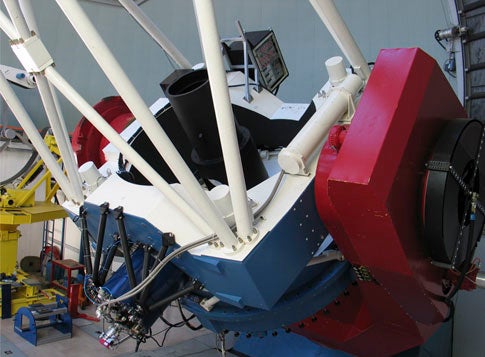A new instrument has seen first light at the ESO La Silla Observatory. Equipping the 2.2-meter MPI/ESO telescope, the Gamma-Ray burst Optical Near-infrared Detector (GROND) takes images simultaneously in seven colors. It will be used mostly to determine distances of gamma-ray bursts.
Taking simultaneous images in different filters is important for the study of many astrophysical sources, in particular of variable sources, such as close binaries or active galactic nuclei. But it is most crucial in the follow-up of gamma-ray bursts. Gamma-ray bursts (GRBs) are short flashes of energetic gamma-rays lasting from less than a second to several minutes. A GRB releases a tremendous quantity of energy in this short time, making it the most powerful event since the Big Bang.
Telescopes discover Gamma-ray bursts, invisible to our eyes, in space. After releasing their intense burst of high-energy radiation, they become detectable for a moment in the optical and near-infrared. This ‘afterglow’ fades rapidly, making detailed analysis possible for only a few hours after the gamma-ray detection. Analysis is particularly important to determine the GRB’s distance and intrinsic brightness.
Distance can be determined first by taking images through different filters, using the so-called photometric redshift. Because a typical GRB afterglow becomes 15 times fainter after just 10 minutes, and over 200 times fainter after an hour, it is important to observe the object in as many filters as possible simultaneously.
“To make the determination of distance of far-away objects as accurate as possible, we decided to use four different filters in the optical and three different filters in the near-infrared,” said Jochen Greiner, who led the development of the GROND instrument.
GROND takes images of the same region of the sky in 7 different filters. The field of view in the near-infrared is 10 by 10 arcminutes, or 1/7th the area of the Full Moon. It is smaller in the visible, slightly above 5 by 5 arcminutes.
GROND is presently in its commissioning phase and its first science demonstration has been achieved, showing that all technical systems work properly. In particular, GROND observed a quasar located more than 12 billion light-years away.
As with many instruments specializing in GRB follow-up, GROND can be activated with a Rapid Response Mode (RRM): GRB alerts will be automatically fed into the system, minimizing the delay between the GRB detection by a satellite, and its observation by GROND.
“The implementation of the RRM at the 2.2-meter telescope is done in exactly the same way as for the Very Large Telescope (VLT), and boosts ESO’s leadership to offer observing systems with ultra fast response time towards GRB follow-up,” said Michael Sterzik, head of the Science Operations Department at ESO in La Silla.
A dedicated data analysis pipeline is also being tested that will provide the distance of the burst a few minutes after the first observations.
“Ultimately, the goal is to trigger ESO’s VLT to perform spectroscopy of the source with fine-tuned settings, thereby maximizing the scientific return of GRB follow-up observations of the VLT,” Greiner said.










